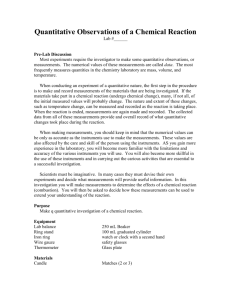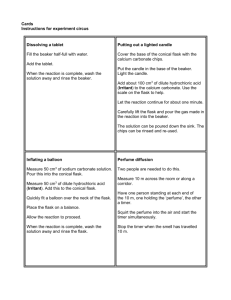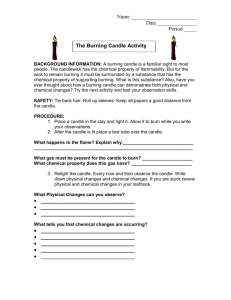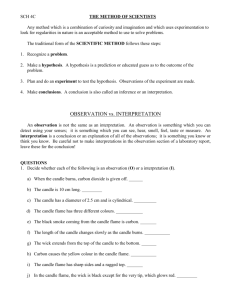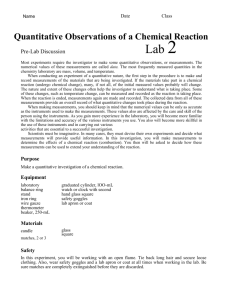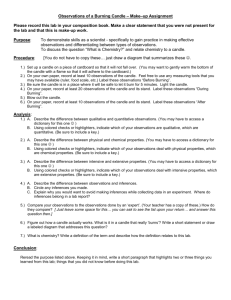Michael Faraday, a 19th century chemist, found much to observe as
advertisement
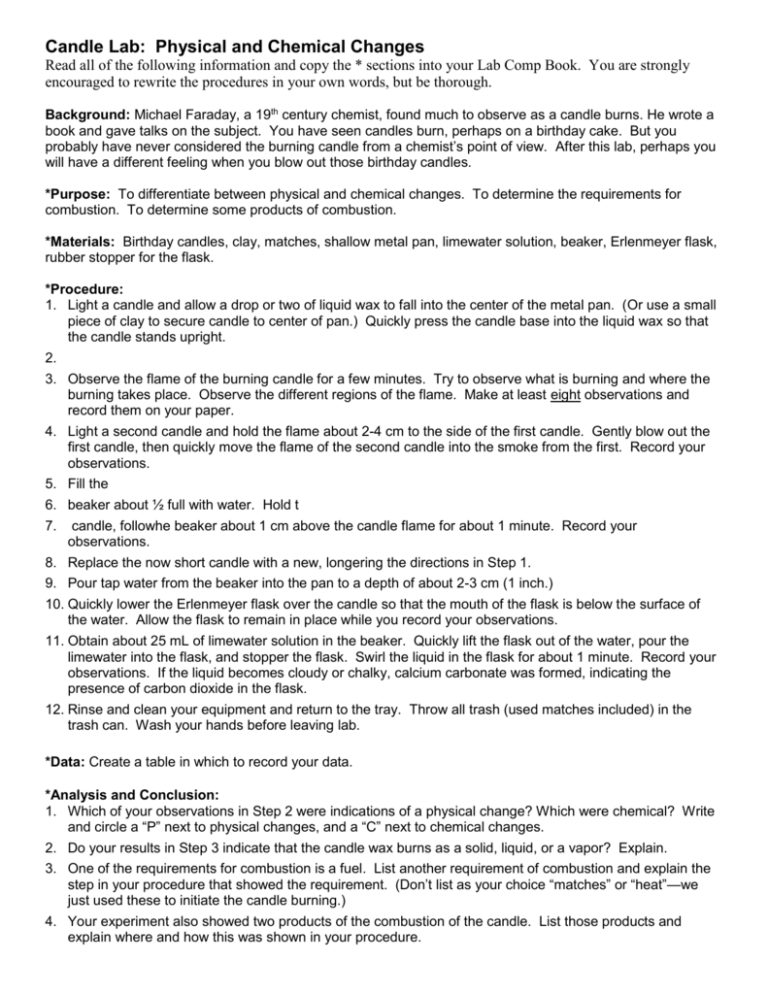
Candle Lab: Physical and Chemical Changes Read all of the following information and copy the * sections into your Lab Comp Book. You are strongly encouraged to rewrite the procedures in your own words, but be thorough. Background: Michael Faraday, a 19th century chemist, found much to observe as a candle burns. He wrote a book and gave talks on the subject. You have seen candles burn, perhaps on a birthday cake. But you probably have never considered the burning candle from a chemist’s point of view. After this lab, perhaps you will have a different feeling when you blow out those birthday candles. *Purpose: To differentiate between physical and chemical changes. To determine the requirements for combustion. To determine some products of combustion. *Materials: Birthday candles, clay, matches, shallow metal pan, limewater solution, beaker, Erlenmeyer flask, rubber stopper for the flask. *Procedure: 1. Light a candle and allow a drop or two of liquid wax to fall into the center of the metal pan. (Or use a small piece of clay to secure candle to center of pan.) Quickly press the candle base into the liquid wax so that the candle stands upright. 2. 3. Observe the flame of the burning candle for a few minutes. Try to observe what is burning and where the burning takes place. Observe the different regions of the flame. Make at least eight observations and record them on your paper. 4. Light a second candle and hold the flame about 2-4 cm to the side of the first candle. Gently blow out the first candle, then quickly move the flame of the second candle into the smoke from the first. Record your observations. 5. Fill the 6. beaker about ½ full with water. Hold t 7. candle, followhe beaker about 1 cm above the candle flame for about 1 minute. Record your observations. 8. Replace the now short candle with a new, longering the directions in Step 1. 9. Pour tap water from the beaker into the pan to a depth of about 2-3 cm (1 inch.) 10. Quickly lower the Erlenmeyer flask over the candle so that the mouth of the flask is below the surface of the water. Allow the flask to remain in place while you record your observations. 11. Obtain about 25 mL of limewater solution in the beaker. Quickly lift the flask out of the water, pour the limewater into the flask, and stopper the flask. Swirl the liquid in the flask for about 1 minute. Record your observations. If the liquid becomes cloudy or chalky, calcium carbonate was formed, indicating the presence of carbon dioxide in the flask. 12. Rinse and clean your equipment and return to the tray. Throw all trash (used matches included) in the trash can. Wash your hands before leaving lab. *Data: Create a table in which to record your data. *Analysis and Conclusion: 1. Which of your observations in Step 2 were indications of a physical change? Which were chemical? Write and circle a “P” next to physical changes, and a “C” next to chemical changes. 2. Do your results in Step 3 indicate that the candle wax burns as a solid, liquid, or a vapor? Explain. 3. One of the requirements for combustion is a fuel. List another requirement of combustion and explain the step in your procedure that showed the requirement. (Don’t list as your choice “matches” or “heat”—we just used these to initiate the candle burning.) 4. Your experiment also showed two products of the combustion of the candle. List those products and explain where and how this was shown in your procedure. 5. What change in water level occurred in Step 7 of your procedure? Propose an explanation for this change. 6. Make at least 2 suggestions would you make for improving the lab or your technique for next time.



